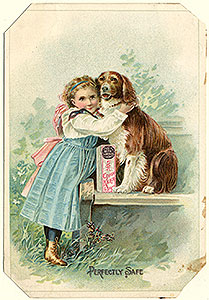Business Advertisement Card: "Dr. Seth Arnold's Cough Killer"
1972.21.0067
Detailed Images
Basic Information
| Artifact Identification | Business Advertisement Card: "Dr. Seth Arnold's Cough Killer" (1972.21.0067) |
|---|---|
| Classification/ Nomenclature |
|
| Artist/Maker | None |
| Geographic Location | |
| Period/Date | 1865 |
| Culture | Euro - American |
Physical Analysis
| Dimension 1 (Height) | 11.5 cm |
|---|---|
| Dimension 2 (Width) | 8.0 cm |
| Dimension 3 (Depth) | <0.1 cm |
| Weight | 3 g |
| Measuring Remarks | None |
| Materials | Paper, Pigment--Ink |
| Manufacturing Processes | Printing, |
| Munsell Color Information | waived |
Research Remarks
| Published Description | N/A |
|---|---|
| Description | Many American advertising cards in the nineteenth century displayed a variety of visual and |
| Comparanda | N/A |
| Bibliography | “A Short History of Trade Cards,” Bulletin of the Business Historical Society 5, no. 3 (April 1931). Berg, Maxine and Clifford, Helen, Selling Consumption in the Eighteenth Century: Advertising and the Trade Card in Britain and France, The Journal of the Social History Society, (April 28, 2015). Chase, Ernest D., The Romance of Greeting Cards, Rust Craft Publishers, 1956. Jay, Robert, The Trade Card In Nineteenth-Century America, University of Missouri Press, 1987. Lewis, John, Printed Ephemera: The Changing Uses of Type and Letterforms in English and American Printing, W.S. Cowell Ltd., 1962. Mehaffy, Marilyn Maness, Advertising Race/Raceing Advertising: The Feminine Consumer(Nation), 1876-1900, Signs, 23, no. 1, The University of Chicago Press, 1997, 142- 143, https://www.jstor.org/stable/3175155. Oatman-Stanford, Hunter, “Extreme Shipping: When Express Delivery to California Meant 100 Grueling Days at Sea,” Collectors Weekly, (June 2, 2016), https://www.collectorsweekly.com/articles/when-express-delivery-meant-100-days-at-sea/. Peterdi, Gabor, “Lithography” section of “Printmaking” article, Encyclopedia Britannica online, 2021, https://www.britannica.com/art/printmaking/Lithography. |
Artifact History
| Archaeological Data | N/A |
|---|---|
| Credit Line/Dedication | Gift of Natalia M. Belting |
| Reproduction | no |
| Reproduction Information | N/A |
